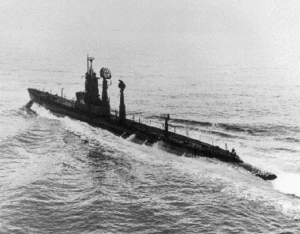USS Tigrone (SS-419)

USS Tigrone (SSR-419) in configuration as a Radar Picket
|
|
| History | |
|---|---|
|
|
|
| Builder: | Portsmouth Naval Shipyard, Kittery, Maine |
| Laid down: | 8 May 1944 |
| Launched: | 20 July 1944 |
| Commissioned: | 25 October 1944 |
| Decommissioned: | January 1947 |
| Recommissioned: | July 1948 |
| Decommissioned: | October 1957 |
| Recommissioned: | 10 March 1962 |
| Decommissioned: | 27 June 1975 |
| Struck: | 27 June 1975 |
| Nickname(s): | Tiger-One |
| Fate: | Sunk as a target off Cape Hatteras, 25 October 1976 |
| General characteristics | |
| Class and type: | Tench-class diesel-electric submarine |
| Displacement: | |
| Length: | 311 ft 8 in (95.00 m) |
| Beam: | 27 ft 4 in (8.33 m) |
| Draft: | 17 ft (5.2 m) maximum |
| Propulsion: |
|
| Speed: |
|
| Range: | 11,000 nautical miles (20,000 km) surfaced at 10 knots (19 km/h) |
| Endurance: |
|
| Test depth: | 400 ft (120 m) |
| Complement: | 10 officers, 71 enlisted |
| Armament: |
|
USS Tigrone (SS/SSR-419), a Tench-class submarine, was the only ship of the United States Navy to be named for the tigrone, a tiger shark found in tropical waters. Her keel was laid down on 8 May 1944 by the Portsmouth Navy Yard. She was launched on 20 July 1944 sponsored by Mrs. Charles F. Grisham, and commissioned on 25 October 1944 with Commander Hiram Cassedy in command.
Tigrone completed fitting out in mid-November and conducted training out of Portsmouth, New Hampshire, and New London, Connecticut, before departing the Submarine Base at New London on the last day of 1944. After ten days of training at the Fleet Sound School, the new submarine got underway on 16 January. Steaming via the Canal Zone, she paused for a week of training off Panama, then set her course for Hawaii, conducting extensive practice approach exercises with attack transport Riverside en route. On 16 February, she arrived at Pearl Harbor to prepare for her first war patrol.
On 9 March, she departed Oahu and steamed westward, arriving at Guam on 19 March. After a three-day pause to repair a main engine, she got underway on 21 March in company with submarines Bullhead and Blackfish, members of a combined attack group, led by her own commanding officer, Commander Hiram Cassedy. Joined by Seahorse, the submarines set their course for the South China Sea where they formed a scouting line in hopes of intercepting Japanese shipping.
...
Wikipedia
